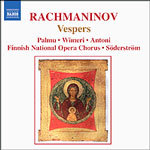
Rachmaninov: All-Night Vigil, Op. 37, Vespers
 $25.00
Low Stock
add to cart
$25.00
Low Stock
add to cart
SERGEI RACHMANINOV
Rachmaninov: All-Night Vigil, Op. 37, Vespers
Eugen Antoni, tenor / Raisa Palmu, soprano / Erja Wimeri, contralto / Finnish National Opera Chorus / Eric-Olof Soderstrom, conductor
[ Naxos / CD ]
Release Date: Monday 6 December 2004
Should this item be out of stock at the time of your order, we would expect to be able to supply it to you within 2 - 5 business days.
Sergey Vasilyevich Rachmaninov was born into a wealthy estate-owner's family near Novgorod. His father squandered the family property, which had to be sold in 1880. The family moved to St Petersburg.
Sergey showed musical talent from an early age. From the age of four, his mother taught him the piano. On the advice of his uncle, the pianist Alexander Ziloti, he moved to Moscow to study the piano and composition. At the Conservatory he completed his final examinations as a pianist in 1891 and as a composer in 1892, and before the turn of the century, his works had already found broad popularity. Disappointed with the cool reception given by audiences and critics to his First Symphony, he focused on a career as a pianist, performing actively in Russia and, from 1899 onwards, in Western Europe.
In the early years of the twentieth century, Rachmaninov entered a new creative period, which culminated in the Second and Third Piano Concertos, the opera Francesca da Rimini and the Second Symphony. He wrote few choral works. His most significant sacred works, the Liturgy of St John Chrysostom (1910) and the All-Night Vigil (1915) date from this second period. Later he wrote no more sacred music.
Rachmaninov had been in contact with Orthodox sacred music since his childhood. The influence of Orthodox chant is clearly detectable in his music, for instance in his use of stepwise motion, a characteristic of Orthodox chant, in his themes. On the other hand, his works also reflect to a great extent the Impressionism and Symbolism of the turn of the twentieth century. His music fascinates the listener with its richness of melodic invention, its Slavic intensity and its incisive rhythms.
Tracks:
01. Come, let us worship 01:41
02. Bless the Lord, O my soul 05:57
03. Blessed is the Man 03:56
04. Gladsome Light 02:41
05. Canticle of Simeon 03:29
06. Troparion for the Virgin Mary 03:25
07. Intonation to the Hexapsalm 02:15
08. Polyeleopsalm 01:56
09. Troparia of the Resurrection 05:18
10. Having beheld the Resurrection 02:57
11. Hymn of Thanksgiving to the Mother of God 06:21
12. The Great Doxology 07:28
13. Troparion of the Resurrection I 01:54
14. Troparion of the Resurrection II 03:09
15. Kontakion for the Annunciation of the Virgin Mary 01:31